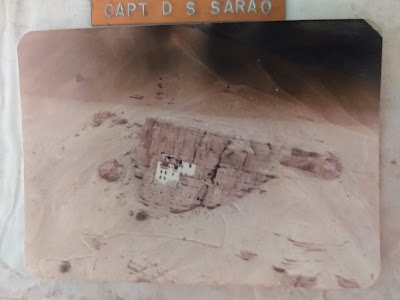THE 'RUM RUN' SORTIE AND THE CHINESE WINE
That pic of the Spitfire (posted some time back), carrying kegs of beer for the troops at Normandy, reminded me of the 'Rum Run Sortie' which was not uncommon in the Eastern sector in the olden days. I remembered that somewhere in the basement dungeon of my house I had a small jerrican of the famous 'ATF' which used to be procured by air crew.
Any one remember?? Must be about 30 years old now---- and still sealed. A friend who was flying in the East had got it for me.


 But there is another story here. This about that fine bottle of Houng´ jioˇ(Mandrain for Red wine) which a Chinese driver gave to me. Actually, in those good old days, not much long ago, the trade at Nathula was basically confined to areas within Sikkim border with only some100 Sikkim-based traders given licence to export about 29 items, while China would export 15. That was the official part. You could see all those Chinese trucks comming with goods and marshalling at a place along the Sherathang-Nathula-Kupup road. All official and nothing restricted about it. Open trade, ofcourse with a little smuggling, which the exise/custom officials on both sides winked at , as long as it was harmless. So, one cold, overcast, dreary day as I was driving along the highway to Kupup , bypassing Nathula, I saw this Chinese driver beside his shiny new (Chinese made truck ) with his hazard lights on (engine trouble). The Chinese driver and his co-driver were a little wary of a military vehicle stopping along. It had started to snow, it was getting dark, low black clouds and the cold was biting. Out of curiousity I stopped alongside and said the only few words of Chinese I knew-- ' Ni Hao'. I was surprised that he could converse in 'pidgin' Hindi. He managed to convey that the others would soon be returning from the marshalling area and he was waiting for a tow/mechanic. The (usual fixture) steel flask in my Gypsy was brought out and I and my driver shared a hot cup of tea with our Chinese traders. As we prepared to carry on, the Chinese driver told me that if I wanted, I could buy a bottle of 'good' Chinese wine. And that is how I am one of the few people in India posessing a bottle of 'Chinese wine'.
But there is another story here. This about that fine bottle of Houng´ jioˇ(Mandrain for Red wine) which a Chinese driver gave to me. Actually, in those good old days, not much long ago, the trade at Nathula was basically confined to areas within Sikkim border with only some100 Sikkim-based traders given licence to export about 29 items, while China would export 15. That was the official part. You could see all those Chinese trucks comming with goods and marshalling at a place along the Sherathang-Nathula-Kupup road. All official and nothing restricted about it. Open trade, ofcourse with a little smuggling, which the exise/custom officials on both sides winked at , as long as it was harmless. So, one cold, overcast, dreary day as I was driving along the highway to Kupup , bypassing Nathula, I saw this Chinese driver beside his shiny new (Chinese made truck ) with his hazard lights on (engine trouble). The Chinese driver and his co-driver were a little wary of a military vehicle stopping along. It had started to snow, it was getting dark, low black clouds and the cold was biting. Out of curiousity I stopped alongside and said the only few words of Chinese I knew-- ' Ni Hao'. I was surprised that he could converse in 'pidgin' Hindi. He managed to convey that the others would soon be returning from the marshalling area and he was waiting for a tow/mechanic. The (usual fixture) steel flask in my Gypsy was brought out and I and my driver shared a hot cup of tea with our Chinese traders. As we prepared to carry on, the Chinese driver told me that if I wanted, I could buy a bottle of 'good' Chinese wine. And that is how I am one of the few people in India posessing a bottle of 'Chinese wine'. The bottle is marked Bingtui Putaojui and my reserach revealed that it is bottled in Jilin Province of the PRC. I was not even aware that there was Chinese wine in existence! Jilin (吉林) is a wine growing province of China which borders North Korea and Russia to the east, Liaoning to the south, and Inner Mongolia to the west. The name "Jilin" translates to 'Auspicious' Forest, a Manchu phrase meaning "along the river".
The bottle is marked Bingtui Putaojui and my reserach revealed that it is bottled in Jilin Province of the PRC. I was not even aware that there was Chinese wine in existence! Jilin (吉林) is a wine growing province of China which borders North Korea and Russia to the east, Liaoning to the south, and Inner Mongolia to the west. The name "Jilin" translates to 'Auspicious' Forest, a Manchu phrase meaning "along the river".
Jilin wine industry now has a production of more than 250 million litres.
Have a sip!!




















